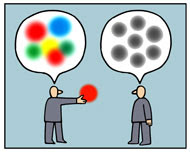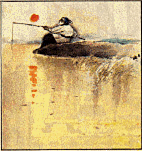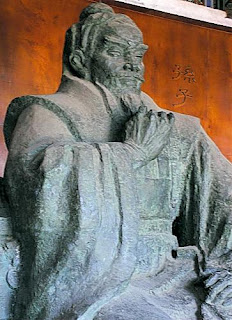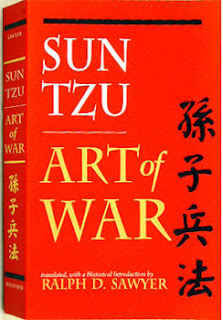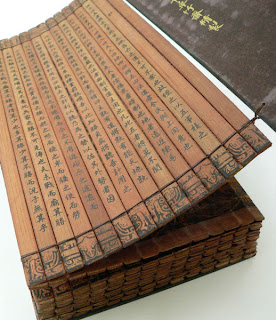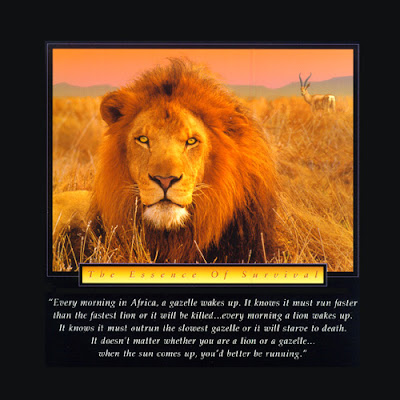 The "To-Do" list is good for individuals, but our Compass AE process is better for the team that collaborates as a team.
The "To-Do" list is good for individuals, but our Compass AE process is better for the team that collaborates as a team.
Users of the "To-Do" List focus on completing the current objective without any conscious regard to any of the milestones ahead. While the Compass AE implementers focus on understanding the grand outcome and how a tactical objective can connect to the other objectives and finally the goal. They have foresight of opportunities and know how to capture it.
They also know which specific tactical list fit into which objective and what part of the list must be adjusted to the objective.
By " . . . focusing on the tactical specifics of their Tangible Vision while minding the Tangible Vision,” the Compass team will complete their grand goal.
# # #
An abridged version of the article.
The Way We List Now
In today's harried society, maintaining 'to do' lists has become a competitive sport, inspiring an array of new products. Katherine Rosman on how to avoid becoming a slave to them.
By KATHERINE ROSMAN
September 29, 2006
Let's jot down a few reasons why lists are the defining organizing principle of the 21st century.
• In the era of Google, Wikipedia and TiVo there is too much information and content and not enough time.
• Mothers leaving executive jobs to stay home with their children are embracing corporate time-management techniques to run their households.
• As BlackBerry usage eradicates complete sentences, items that can be quickly ticked off have become the accepted shorthand.
• In a post-Sept. 11, post-Hurricane Katrina world, people see lists as a way to prepare for inevitable disasters.
A range of companies, including Amazon.com, book publishers, stationery makers and Internet sites, are pushing new products aimed at the growing appetite for list-making. Within the next year, publishing houses will roll out at least eight books of lists. One will feature images of nearly 300 food-shopping lists that were found near supermarkets around the country. Others include a memoir culled completely from one woman's collected to-do lists, and "Mountain Man Dance Moves: The McSweeney's Book of Lists," a compilation of satirical lists like "The Collected Apologies of Lawrence H. Summers, President of Harvard."
Major media companies are funding, buying and starting up list-centric Web sites. Next week, Barry Diller's IAC/InterActiveCorp will launch a beta version of Very Short List (veryshortlist.com), an email newsletter and Internet site dedicated to quick recommendations of media and culture. Amazon.com is funding a company that runs several list sites, including allconsuming.net (where people catalog the books, movies and music they own) and 43things.com (where users list up to 43 things they want to do before they die). On the networking Web site Consumating, which was bought last year by CNET Networks, users' main profiles consist of a simple list of adjectives and interests, also called tags. "It's a succinct way of explaining to someone who you are," says Ben Brown, the site's founder.
Looking for Order
Several factors are feeding the commercial growth: Lists are a cheap, fast way for publishers and Internet sites to generate new content -- especially online, where users are often creating the lists themselves. As consumers face more ways to spend their time and money, companies hope their bullet-point, short-attention-span offerings will appeal to even the most time-starved. Lists also offer order, real or perceived, in a chaotic world. "People have a hunger for patterns and order and stability in a rapidly changing world," says Ben Dattner, a professor of organizational psychology at New York University.
Executives often manage by lists. Bob Cancalosi, the chief learning officer for GE Healthcare, a division of General Electric, keeps "microlists" for daily tasks, which he constantly compares to his "mothership list" about the company's management philosophies and goals. Individual projects get their own lists -- for one leadership class, he writes a 450-item checklist 125 days before the event. Weekends are no different. Every Saturday morning, he brews a pot of coffee and makes a list, with items like "buy gallon of milk," "take daughter to piano" and "run three miles." "I think I'm a little anal," he says.
KEEPING ORDER ONLINE
| A crop of new Web sites allow people to create and share lists, on everything from a baby's nap schedule to an action-figure collection. Below, five sites that aim to help people get organized. |
| WEB SITE | COMMENTS |
| diyplanner.com1 | Douglas Johnston, a multimedia project manager, founded this site devoted to downloadable paper lists and planning kits while he was living in Newfoundland, Canada. (It was too far to drive to a store for day-planner refill pages.) Available templates include "Goal Planning" and "Checklist." Since the site launched in September 2005, about 800,000 template kits have been downloaded, says Mr. Johnston. |
| recipething.com2 | Influenced by Web site LibraryThing, RecipeThing (launched three weeks ago by a husband-and-wife team) allows home cooks to enter and organize their recipes by tags like vegetarian or tailgating -- and access those of others. So far, 800 users have added 2,014 recipes. |
| squirl.info3 | On this site, introduced last month, nearly 1,000 people have logged lists of their collectibles, including records, "Star Wars" action figures and autographed copies of Sports Illustrated. Co-founder John McGrath says that he plans to integrate an option allowing users to sell their items at online auction houses. |
| tadalist.com4 | Ta-Da allows users to create online to-do lists that can be shared, free of charge. For project collaboration, several users can access the same tasks and check off items as they're accomplished. The site was launched in January of 2005, and in the last year, users have added 1.4 million to-dos. |
| trixietracker.com5 | After maintaining a blog for three years that listed his baby's feedings, sleep patterns and dirty diapers, Ben MacNeill of Chapel Hill, N.C., created software for other new parents to do the same. (A subscription costs $14.95 for three months.) Since the site's launch in March 2006, members have logged more than 100,000 naps. |
Every Sunday night, Pamela Salzman, a 36-year-old M.B.A. in Los Angeles who worked in marketing and public relations before having kids, says she writes a master list of the errands and obligations she must complete in the coming week. Each morning, she creates a daily list, pulling tasks from the weekly list. Then there is her "major project list" with items such as "reorganize my 2005 photo album," and lists of gifts given, what to do when the kids get sick and a timeline for preparing Thanksgiving dinner. Mrs. Salzman says making lists is a stress-reliever. "When I can see everything in front of me," she says, "it feels like it's more within my control."
Nancy Paul, one of Mrs. Salzman's best friends, has another system, which she credits to her corporate experience. In a small binder she keeps at the ready, Ms. Paul, 40, jots notes on specially designated pages, indicating such things as gifts to buy, people to call and things to tell the interior designer. She also gives the family baby sitter a list of tasks to complete while the children nap, like replacing old markers with new ones. "I graduated from business school, and I use a lot of techniques I learned" there, says Ms. Paul, a former executive at Walt Disney Co.
Along with three other close friends, Ms. Paul and Mrs. Salzman discuss, borrow, covet and critique one another's lists. "I wouldn't call it competitive list-making," says Mrs. Salzman. "But it is envious."
Lists, of course, have been around since man put chisel to stone. The British Museum in London houses what is thought to be one of the oldest surviving lists -- it's a menu or grocery list dating back to around 80 A.D. written on a thin wooden tablet in Latin. (Not much has changed: It calls for olive oil and wine.) Historians say the Buddha and Thomas Jefferson were inveterate list makers. Charles Darwin notably wrote one titled "To Wed or Not to Wed" that included one advantage of a wife: "better than a dog anyhow." In the 1970s, "The Book of Lists," covering topics like movies, animals and crime, became a best-seller. A revised edition, "The New Book of Lists," was released last November.
Technology is a big part of what's driving the interest in lists. The new online sites make it possible to maintain and search through giant inventories of content. Apple Computer's iTunes, for example, offers over 3.5 million songs.
This also comes as consumers are overloaded with options. The average Barnes & Noble store holds 100,000 books. In 2005, 549 new films were released, up 5.6% from 2004, according to the Motion Picture Association of America. Netflix has an inventory of 65,000 DVD titles. People are struggling under an unparalleled glut of information and media, says John Warner, editor of the forthcoming book "Mountain Man Dance Moves." "Choice is paralyzing," he says.
... Stationery companies are cashing in on the list's new luster. Knock Knock, a company with paper products sold in 5,000 retail outlets, stocks 21 different list-formatted pads this year, representing 22% of the company's year-to-date revenue of $2 million. That's up from eight pads totaling 12% of revenue in 2005. Reading-tool and desk-supply retailer Levenger is counting on "list-building" products as its greatest growth opportunity. Year-to-date sales of its best-selling list product (a $38 pocket-sized leather note-card holder) are up 56% over last year, says Steve Leveen, the company's co-founder and chief executive. "We'd like to be the Starbucks of note-taking and list-making products," he says. Another stationer, MomAgenda, says revenue from notepads with to-do lists doubled in the first nine months of this year over last year. Its top seller: a menu planner affixed with a magnet for display on the refrigerator.
Yet too many lists can cause problems. Grant Newman, a first-year M.B.A. candidate at Duke University, has been making lists since middle school. Each day, he writes "tactical lists" with items like "do problems for statistics" class and "make sure I send Mom a birthday card." He throws away those lists when the tasks are complete. But he holds onto all of his "strategic lists" -- "get into a top M.B.A. program" (mission accomplished!) and "learn Spanish" -- and only occasionally consolidates partially completed lists. The list pileup was the cause of many arguments with Mr. Newman's ex-girlfriend. "His whole dining room table was covered with lists, bills and old newspapers. Just covered," says his ex, Ana Perez, who lives in Chicago. "It was really bad."
It's a good idea to go through lists periodically to knock out unnecessary items, and consolidate as much as possible, organizational experts say. Keep all resource lists in one place -- books to read, museums to visit -- whether it's in a notebook or in a single computer file. And to-do lists shouldn't become endless "mind dumps," says Julie Morgenstern, a New York time-management consultant who advises corporate and individual clients on how to get organized. After writing down what needs to be done, list-makers should identify how long a task will take and when it will be completed. "A 'to do' that is not connected to a 'when' rarely gets done," says Ms. Morgenstern, who has a line of paper day planners coming out next month from FranklinCovey.
/// *** Our Compass AE covers that and more
As a vast repository of information, the Internet has given rise to many kinds of lists that aim to help consumers make sense of it all: Frequently Asked Questions, the Netflix "queue," craigslist and Amazon.com's Listmania. Social-bookmarking site del.icio.us, which was bought in December by Yahoo, categorizes sites recommended by others, with tags like "interesting" or "oil." Membership on Angie's List -- a clearinghouse of user ratings for service providers in 72 cities nationwide -- has doubled to more than 500,000 in the past year, according to a company spokesman.
Subscribers to the new Very Short List will receive a free daily email with one pick -- such as a book, song, video or movie. The company plans to earn revenue from advertising and other transactions. "People feel they're drowning in choice and are desperate to go into a curated space," says Michael Jackson, IAC's president of programming.
READING LISTS
At least eight publishers plan to release books about lists in the next year. Here are five titles in the works.
| TITLE/PUBLISHER/DATE: | COMMENTS |
"Milk Eggs Vodka: Grocery Lists Lost and Found"
HOW/May 2007 | After finding a discarded grocery list outside a supermarket 10 years ago, St. Louis-based photographer Bill Keaggy began a collection, and he now has more than 1,000. His book is divided into chapters, like lists that seem to be for party preparations (chips, salsa, beer, paper plates) and "sad lists," some of which include a lot of medications. |
"Things to Bring, S#it to Do... and other inventories of anxiety"
Stewart, Tabori & Chang/September 2006 | Writer Karen Rizzo compiled this memoir after she discovered her father's boxes full of old lists -- and realized a list can say a lot about a person. Her book reprints some of her own, including a to-do list from October 1989 with items like: "new black Reebok sneaks" and "toss everything with shoulder pads." A November 1993 list entitled "I must read before I get married" includes Dante's "Inferno" and "Crime and Punishment." |
"To-Do List"
Simon & Schuster/October 2007 | Sasha Cagen, the former editor of the defunct To-Do List magazine, is editing this compilation, which includes a color-coded accounting of 69 people one woman had amorous relations with and how to start your own church. "They're even more revealing than a diary entry," she says. "They're written about what people want in a way that's not very self-conscious." |
"Trivia Lovers' Lists of Nearly Everything in the Universe"
Random House Reference/October 2006 | This is Barbara Ann Kipfer's 15th book on lists, which will weigh in at 656 pages -- she is the author of "14,000 Things to Be Happy About" and "The Wish List." She has also worked up lists of synonyms: She's the editor of "Roget's International Thesaurus (Sixth Edition)" and "Roget's 21st Century Thesaurus." |
"Your Personal Assistant"
ReganBooks/TBD | Barbara Guggenheim has managed a bicoastal career -- she is an art consultant with offices in New York and Los Angeles -- and a marriage to a member of the Hollywood power structure -- her husband is attorney Bert Fields -- by keeping lists. She plans to publish 300 of them, with co-author Nadine Schiff, along with a CD-ROM to download and edit each one. |
Part of the draw of list sites is voyeuristic. By early next year, Very Short List users should be able to create their own recommendations and share them online. "It's always fascinating to look at someone's list," Mr. Jackson says.
Another site, LibraryThing, allows users to publicly catalog their books and organize titles in multiple ways, such as era, subject matter or genre -- or just browse through other people's libraries. Since LibraryThing launched in August 2005, about 84,000 members have listed almost 5.9 million books.
A growing clutch of Web sites are using lists as a launching pad into the booming social-networking market. The Robot Co-op, a two-year-old company that is wholly funded by Amazon.com, has five list-centric sites on which users can post their own lists and find people with similar tastes and interests -- from books to DVDs to lifetime goals. Its goal-oriented site, 43things.com, had nearly 1.4 million unique visitors in August, more than three times the number in August of last year, according to comScore Media Metrix.
Posting recommendations from other consumers can also appeal to companies looking to replicate the experience of "social shopping," with a little peer pressure mixed in, at home. "If someone else has all of the records that I have, but there is one they have that I don't have, that could induce me to buy," says Patti Freeman Evans, Jupiter Research's senior retail analyst.
Jennifer Scully-Lerner, a vice president for private wealth management at Goldman Sachs in Manhattan, considers lists an easy-to-digest language that is compatible with the quick pace of BlackBerry-influenced corporate culture. Ms. Scully-Lerner has become well known at Goldman Sachs for her "Organization List to Prepare for Baby." It recommends buying more than 90 separate items and makes 15 suggestions under the heading "General Notes." The list has been widely circulated throughout her office and beyond.
Using Microsoft Word, Excel, errant scraps of paper and her BlackBerry, Ms. Scully-Lerner makes lists that govern almost every aspect of her life. She has lists of work projects all around her desk. There's a packing list on her closet wall, to simplify the preparations for her frequent business trips. She has emergency lists at home and at work. She keeps lists of books to read, phone calls to make and presents to buy. She also maintains a list of gifts she'd like others to give to her. "My husband tells people it's my purchase order," she says. "I'm a list freak."
Write to Katherine Rosman at katherine.rosman@wsj.com6
http://online.wsj.com/article/SB115948761037977424.html###
More information on "The List":
http://www.todolistblog.com/
http://www.davidco.com/what_is_gtd.php
